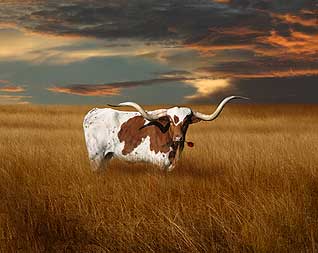
HOW A PEDLER SAVED THE TEXAS LONGHORN MARKET
By Bob Jamison
Quite unassuming was the talent of a half-breed Cherokee Indian by a Scottish father had ambitions to build up trade with the Indians in Oklahoma (then Indian Territory). He set up trading post along the way and as the markets developed for this entrepreneur named Jesse, he capitalized with his trail side outpost from south Texas to Kansas. Furthermore, he spoke over thirteen dialects of the Indian language and became an important interpreter to Sam Houston. He was well known and respected for his honesty and independent thinking.
In the throws of post Civil War, Texas had only one major asset and that was the Texas Longhorn cattle numbering in the thousands. However, these hardened and near wild beast had little value. Then drivers followed the mud tracks left by Jesse with cattle up through Austin, San Antonio, Fort Worth, Denison and entering the Red River near Montague County, Texas. This trail lead the cattle market to and through Indian Territory and eventually to the beef starved north east from Kansas.
Trouble began when Missouri and parts of Kansas became quarantined against Texas cattle under certain evidence that the Longhorn cattle were bringing parasites eventually referred to as the Texas Fever Tick. It became a near civil war with Kansas and Missouri land owners who were cattlemen themselves, began fencing off the directions headed by pistol packing cowboys from Texas.
The need for the drives was so great because of a ready Kansas market that were paying up to $40 per head for cattle arriving by Jesse’s wagon rut roads while they were worth only $4 per head in Texas. This meant that regardless of Jesses’ intent to sell goods to the Indians, cattle drives paled the need developed by this tough and ingenious marketer of goods.
Texas rancher O. W. Wheeler bought 2400 steers in l867 with the intent to drive the cattle from San Antonio westward to winter the heard on the western plains and make his sale in California. That area also flourished after the discovery of gold around l849 which made a very attractive market also.
However, as they reached the Canadian River they noticed the well traveled road northward to a closer market. This trail was referred to as the Abilene Trail or the Kansas Trail continuing north above Indian Territory. The serious dispute over the quarantine area was thoughtfully moved westward in Kansas to the village of Abilene, Kansas that was outside the Fever Tick quarantine.
Hundreds of thousands of Texas Longhorn Cattle made that drive and the trail grew larger and even more civilized as building commercial markets and eventually railroads that, for a great extent, made important use of this original trail well marked by the half-breed peddler named Jesse. In fact, it became the dream and brain trust of the famous Missouri, Kansas, & Texas railroad.
Other ranchers that gained much fame in Texas were Captain Richard King and Abel (Shanghai) Pierce. Also, John T. Lytle and partners trailed about 600,000 head of cattle. Charles Goodnight along with an Irish financier John Adair developed a syndicated ranch known as the Scottish Prairie Land and Cattle Company and the Matador Land and Cattle Company to further develop cattle herds.
The amazing Texas Longhorn Cattle certainly made a mark in history of their treks to the eastern markets. Many thought the cattle that survived the harsh terrain and often difficult weather conditions would be virtually worthless at the end of the trail. On the contrary, these cattle were known to have gained weight on the trip. This was mainly due to their conditioning on simple needs of their early existence. Of course, knowledgeable handling by the wise ranchers and their hands knew when to rest the cattle and allow them proper grazing and water along the trail.
Eventually, the rail road took over the long cattle drives. Those lands became fenced and train personnel established resting pens and pastures along the way. The term “cow poke” likely began during the shipping of cattle on the trains. Whereas, the trains were obliged to stop for water frequently, the “cow pokes” would walk by the rail cars and ‘poke’ up any cattle that might have fallen or were simply lying down. Poking them with a stick was to protect them from being trampled.
Of course, “cow pokes”, trail drovers, famous ranchers, and even foreign investors never quite realized just how important it was that the Scot-Cherokee Jesse blazed this trail. Of course, Jesses’ full name was Jesse Chisholm. And now that important Katy Railroad (MKT) is still essentially remembered as the Old Chisholm Trail.